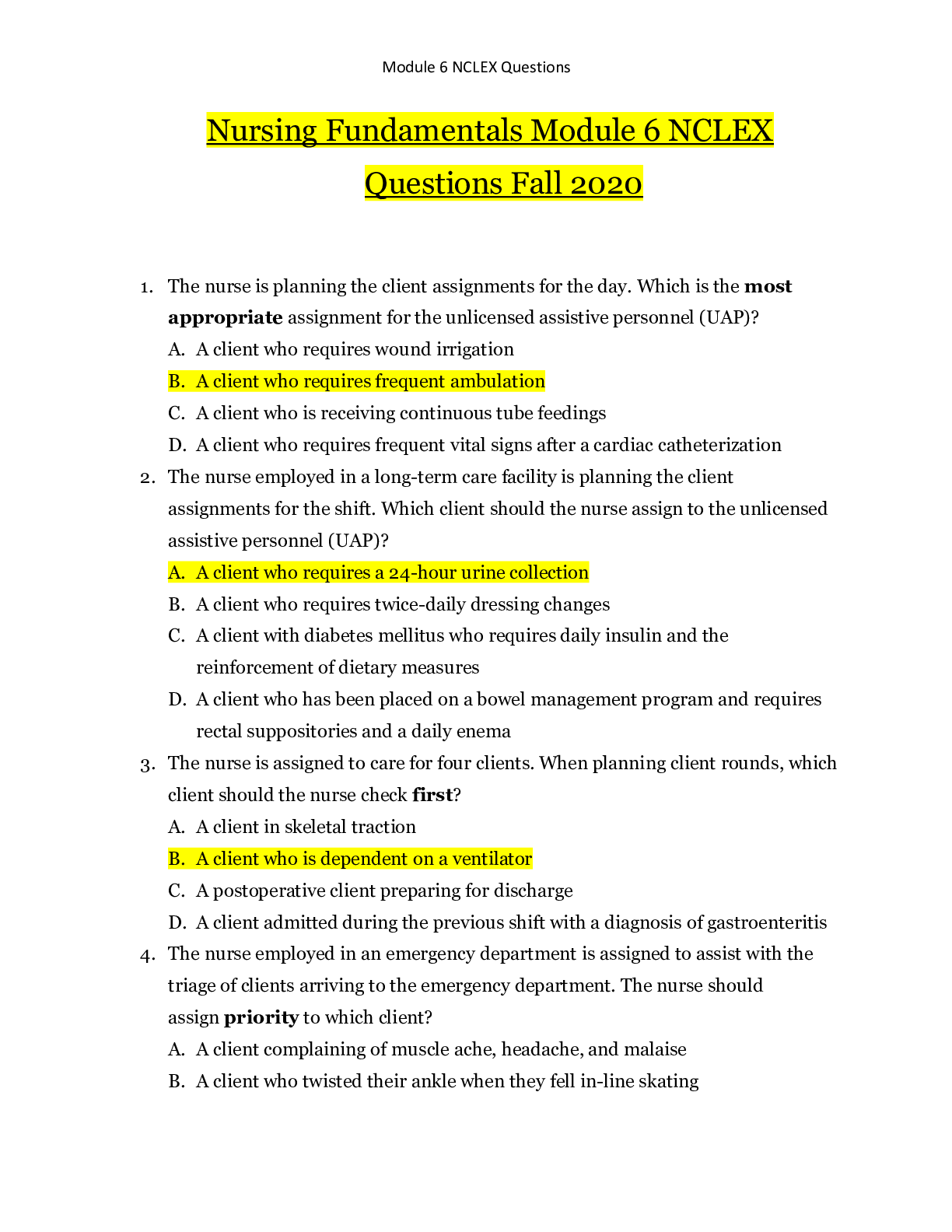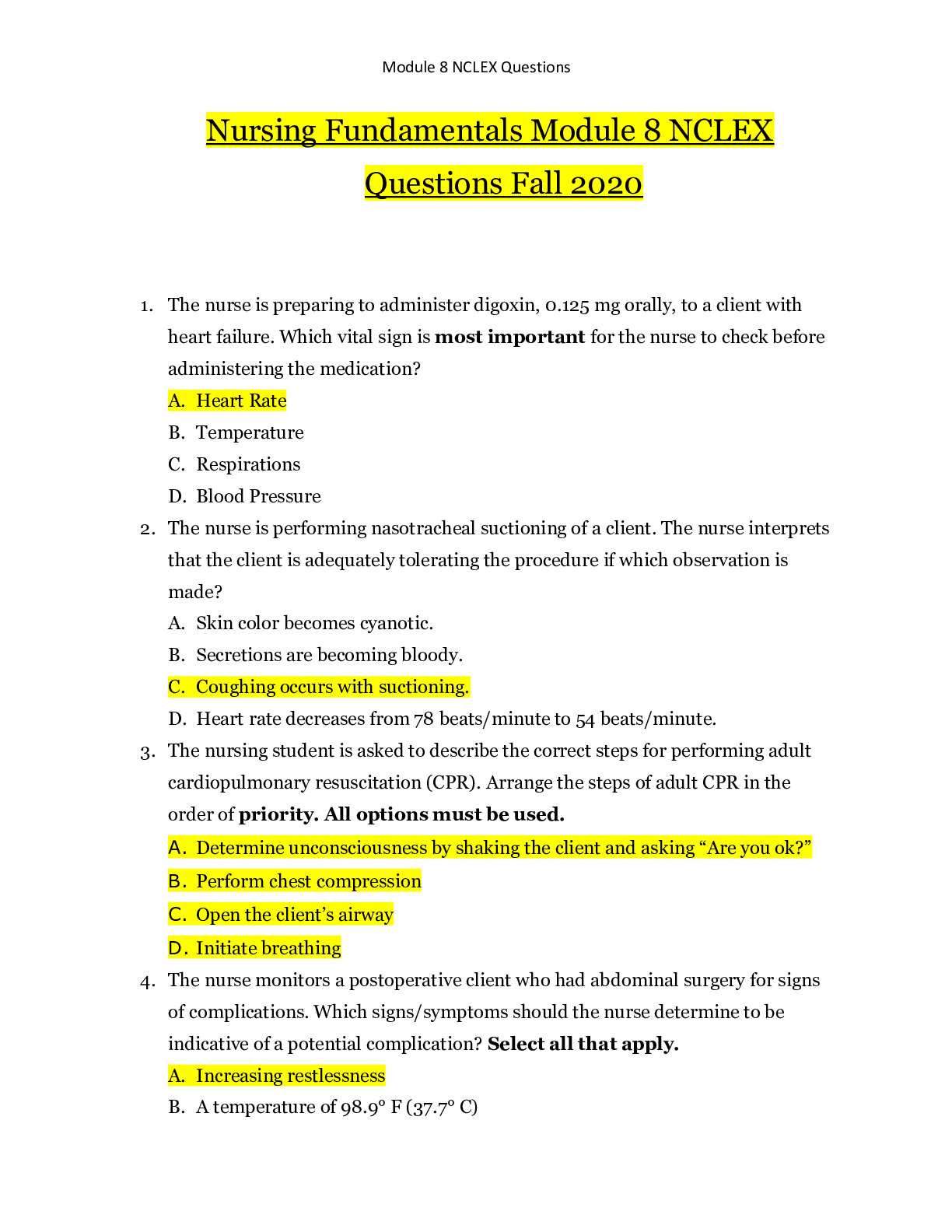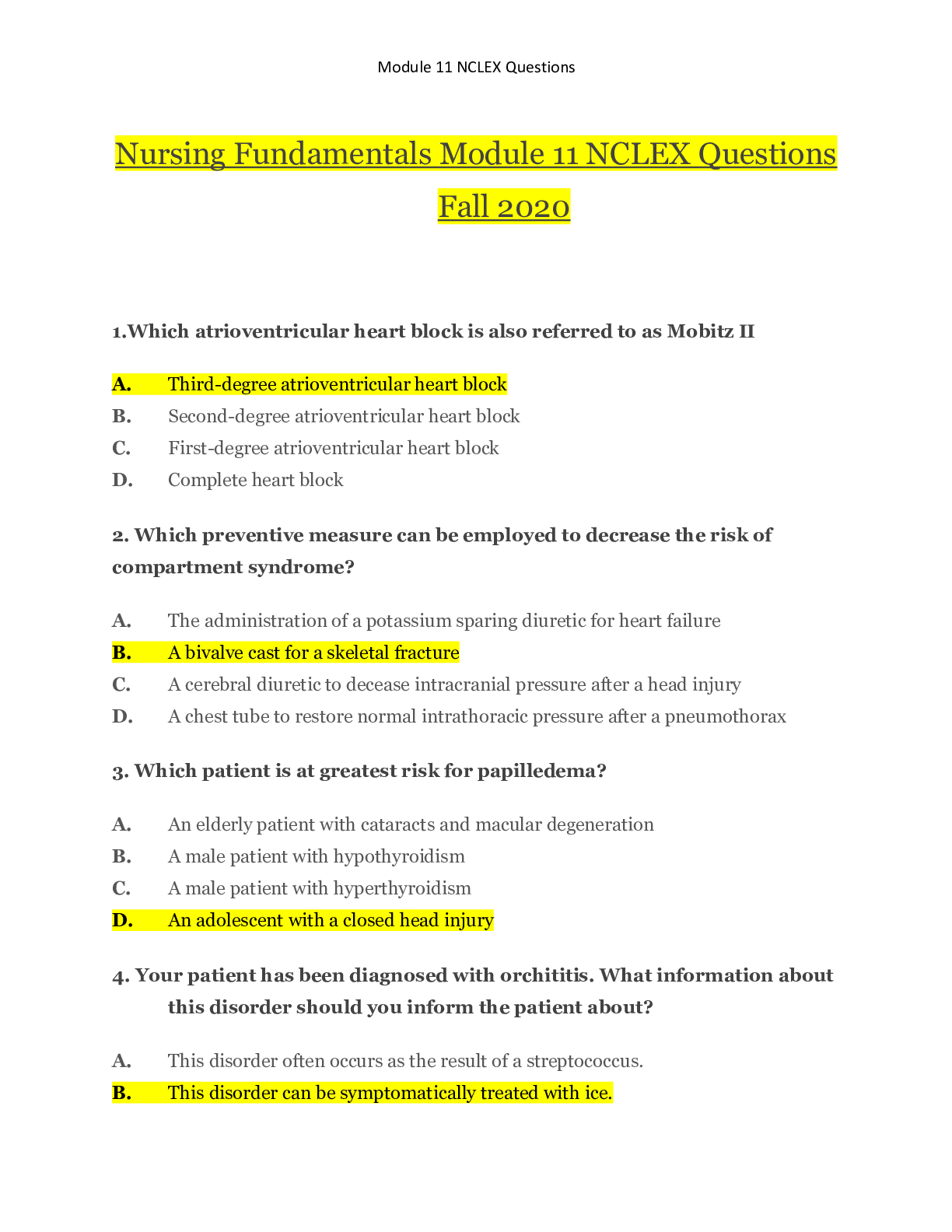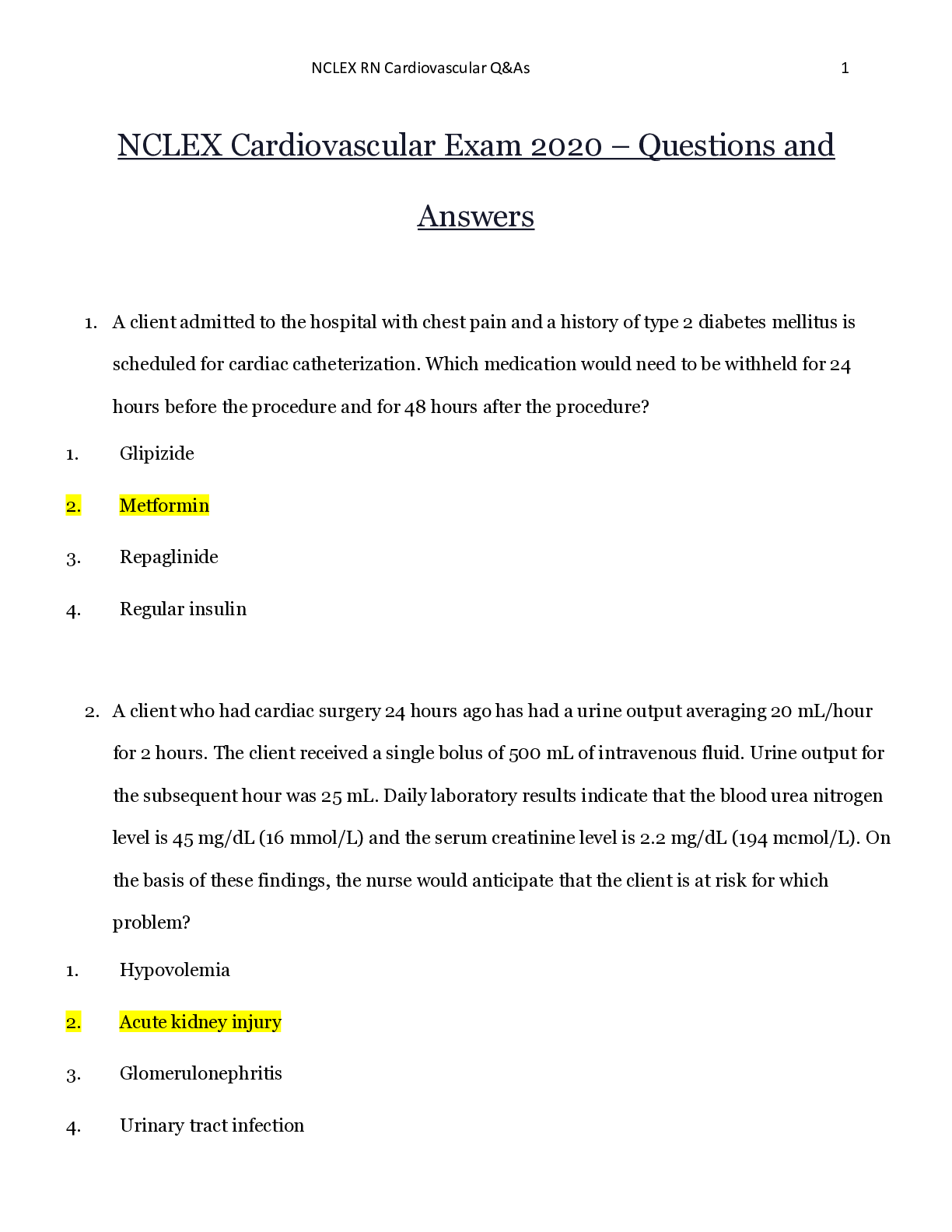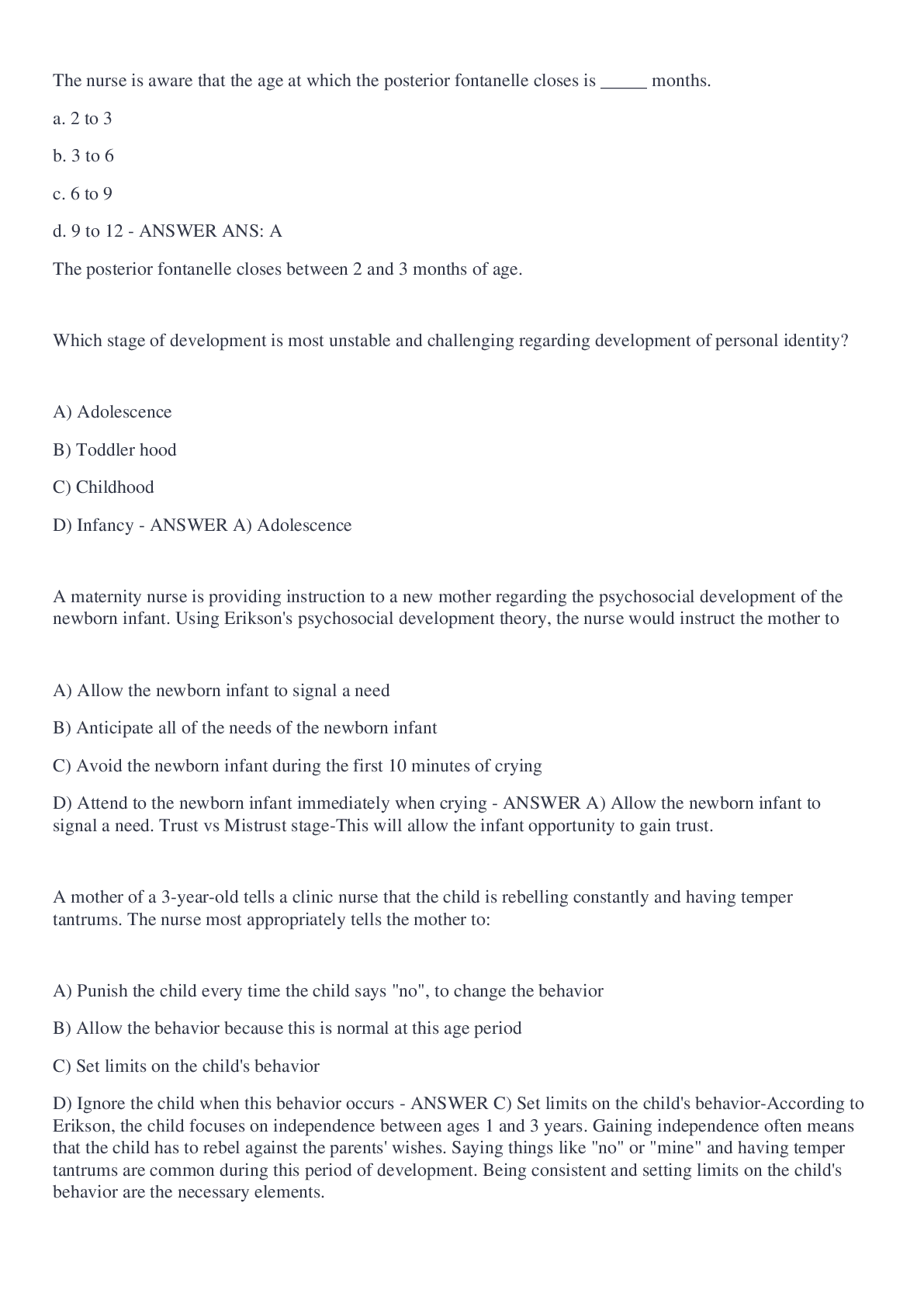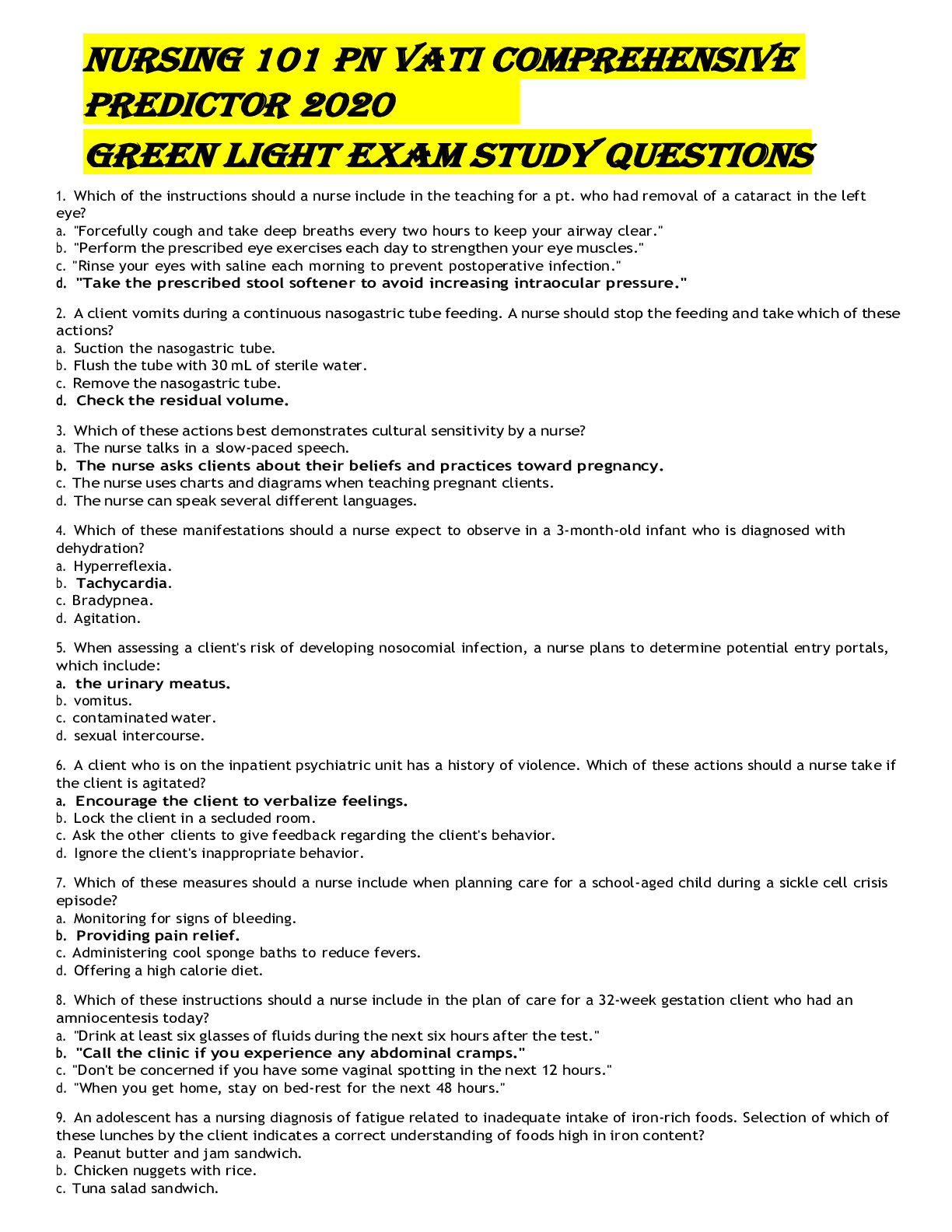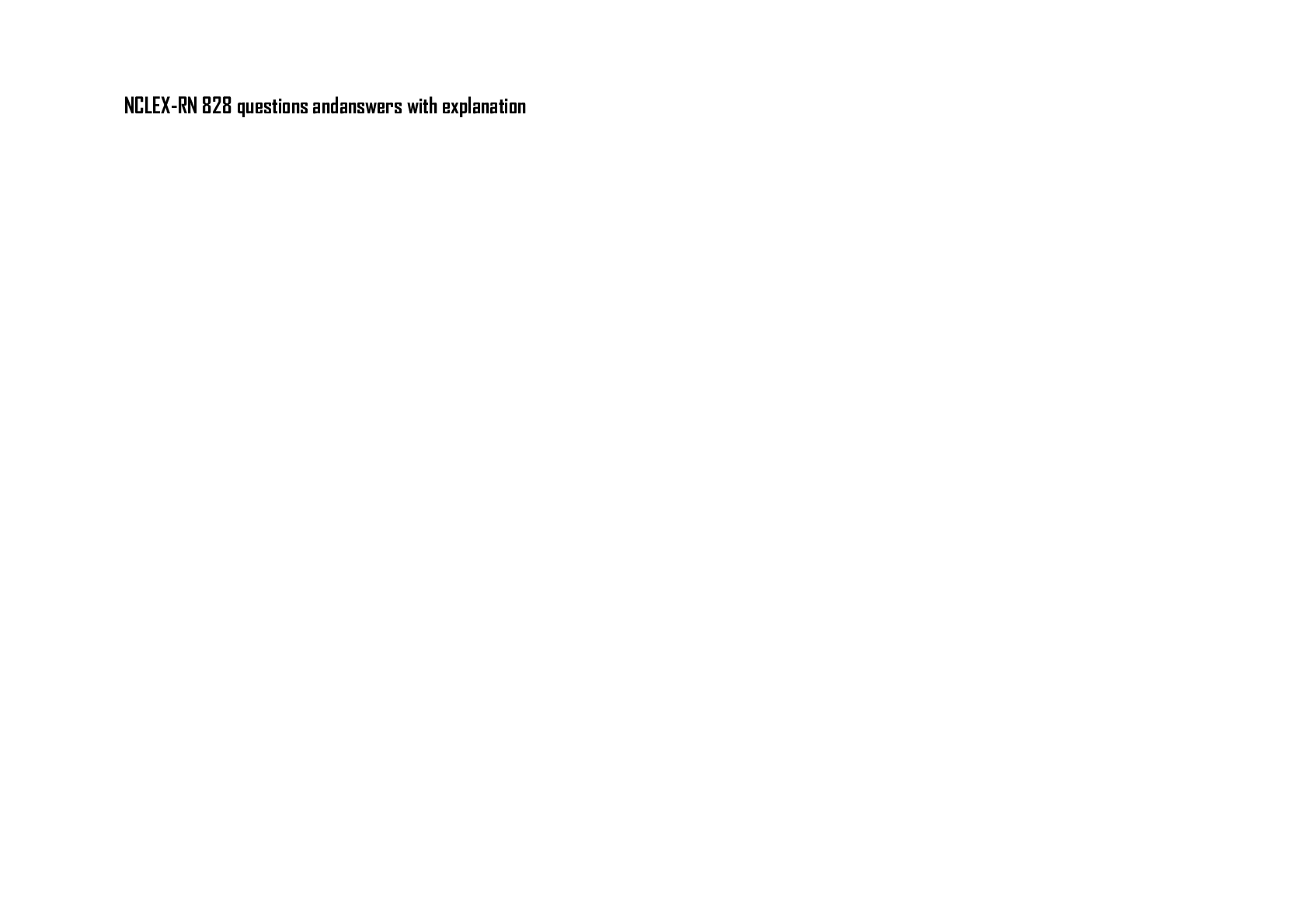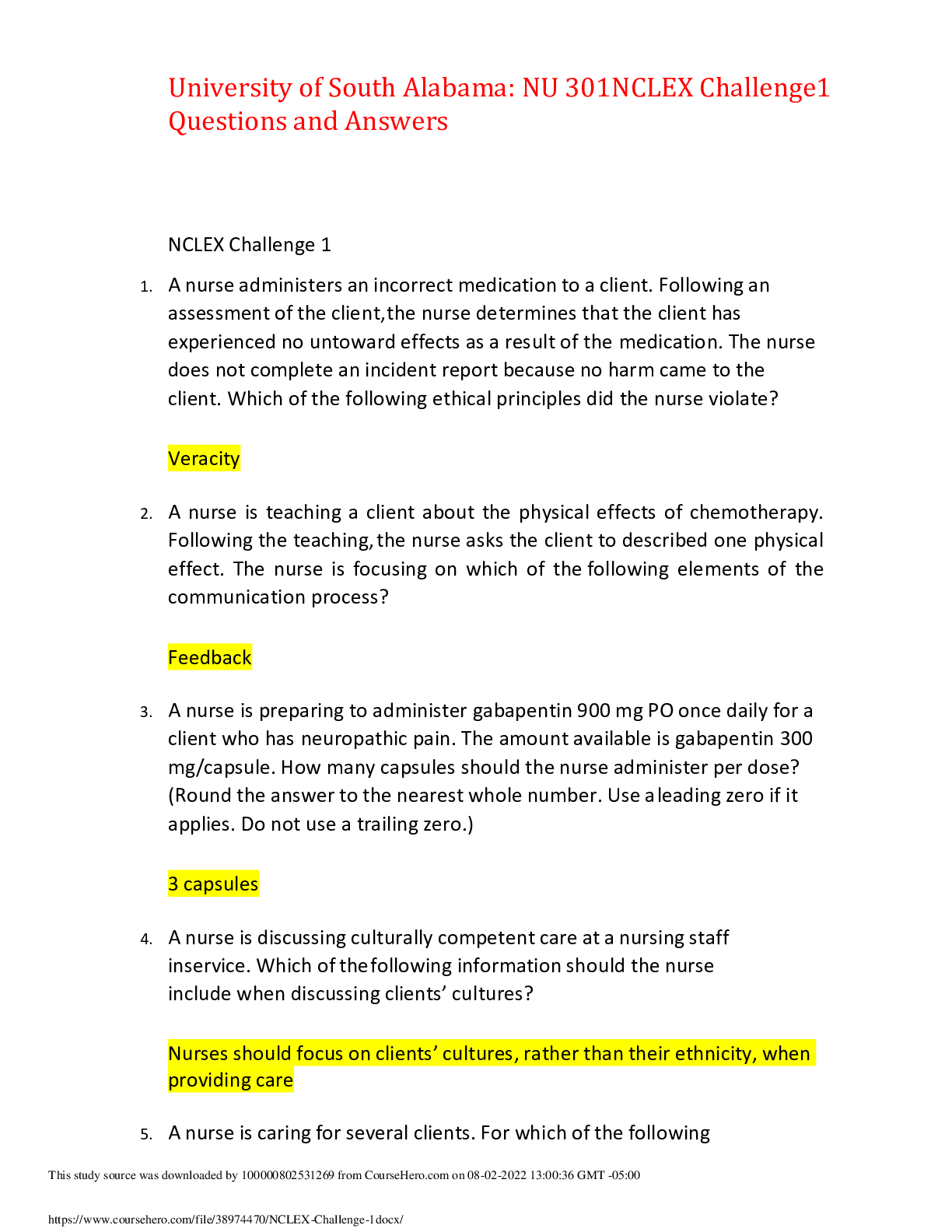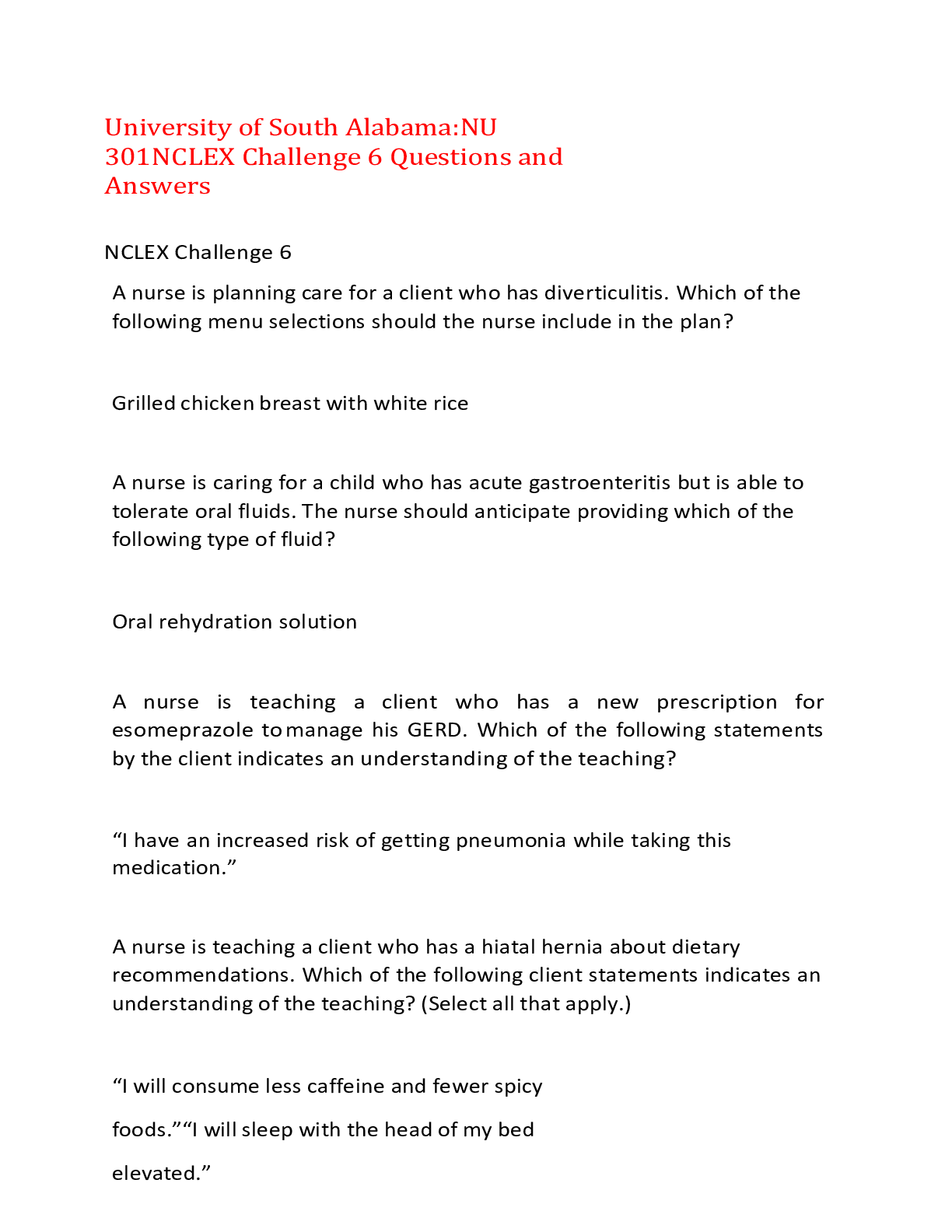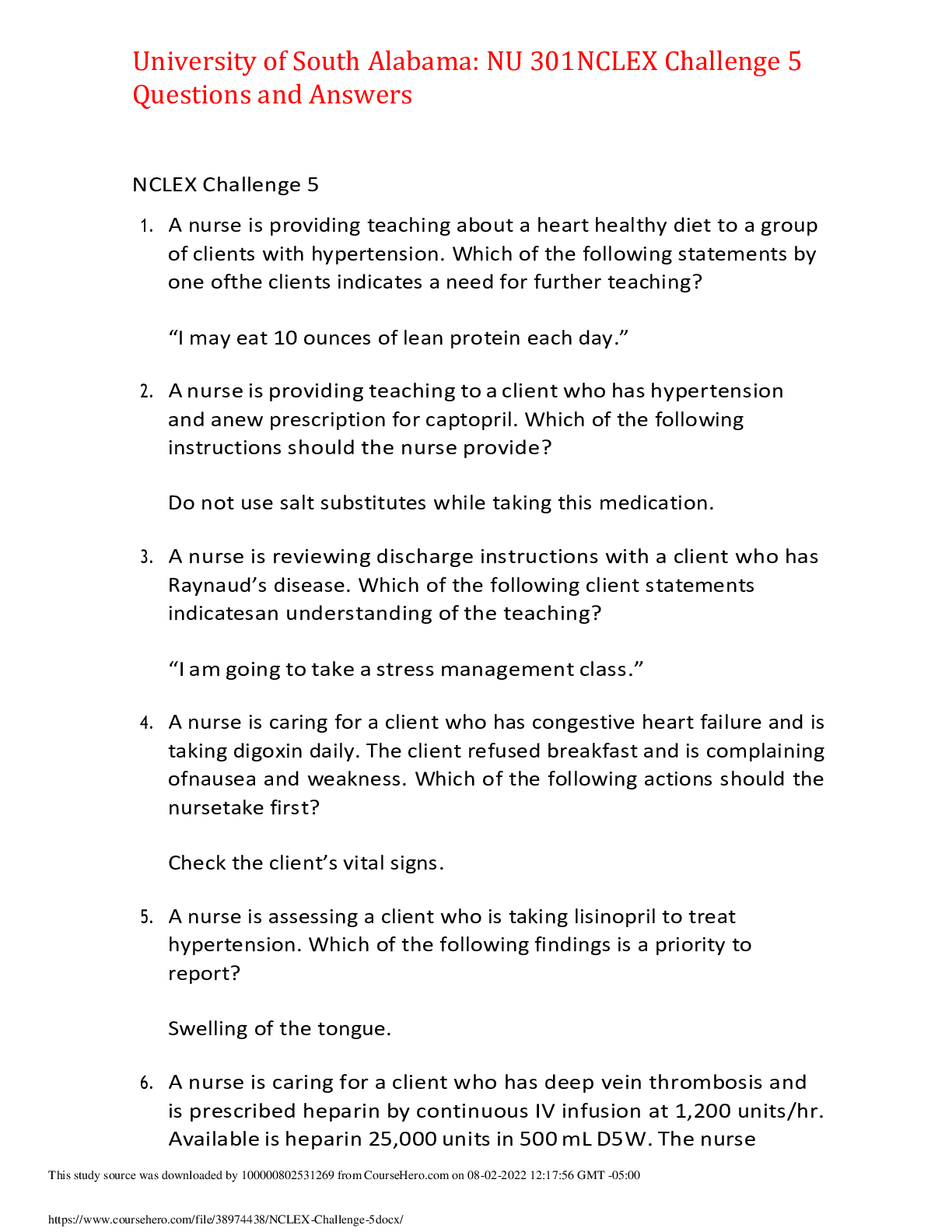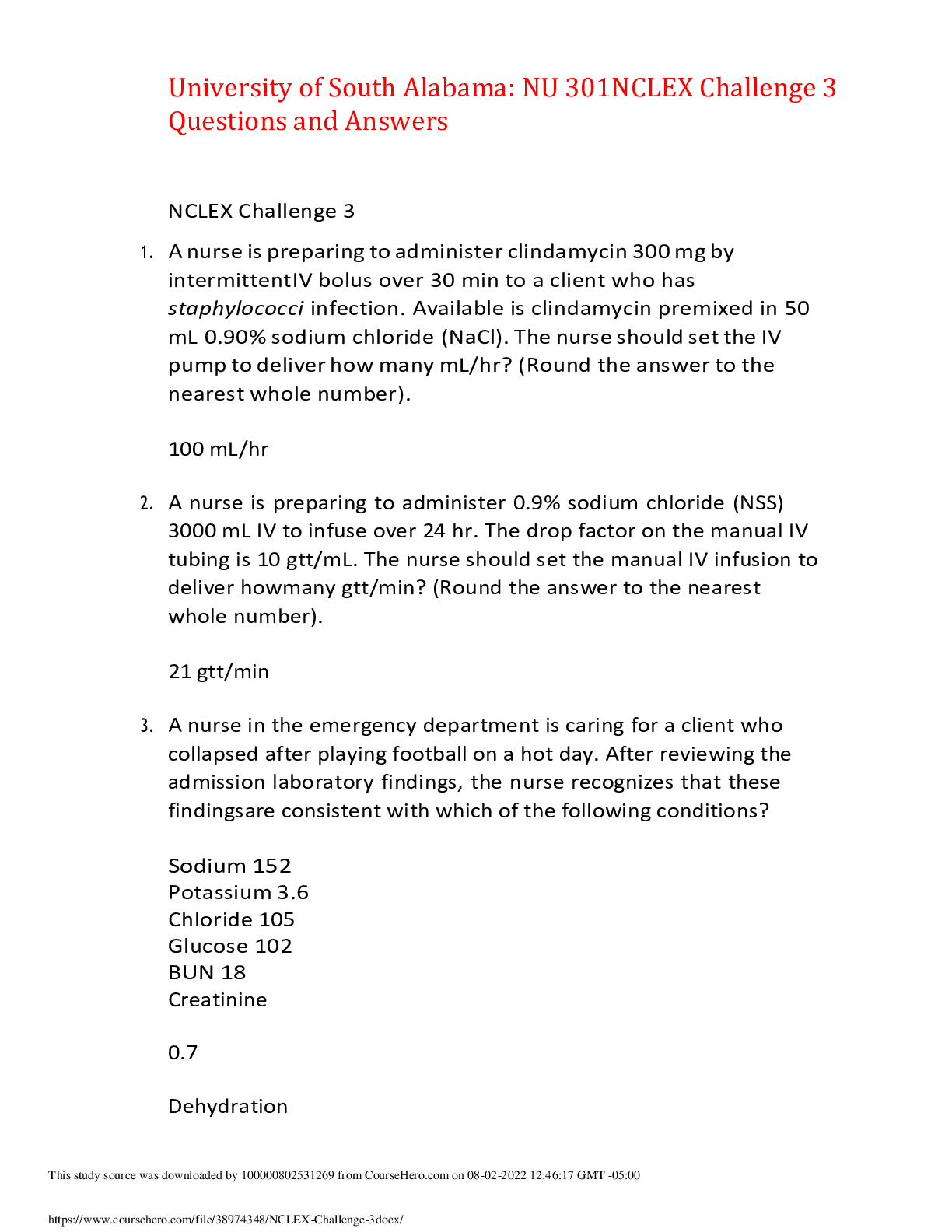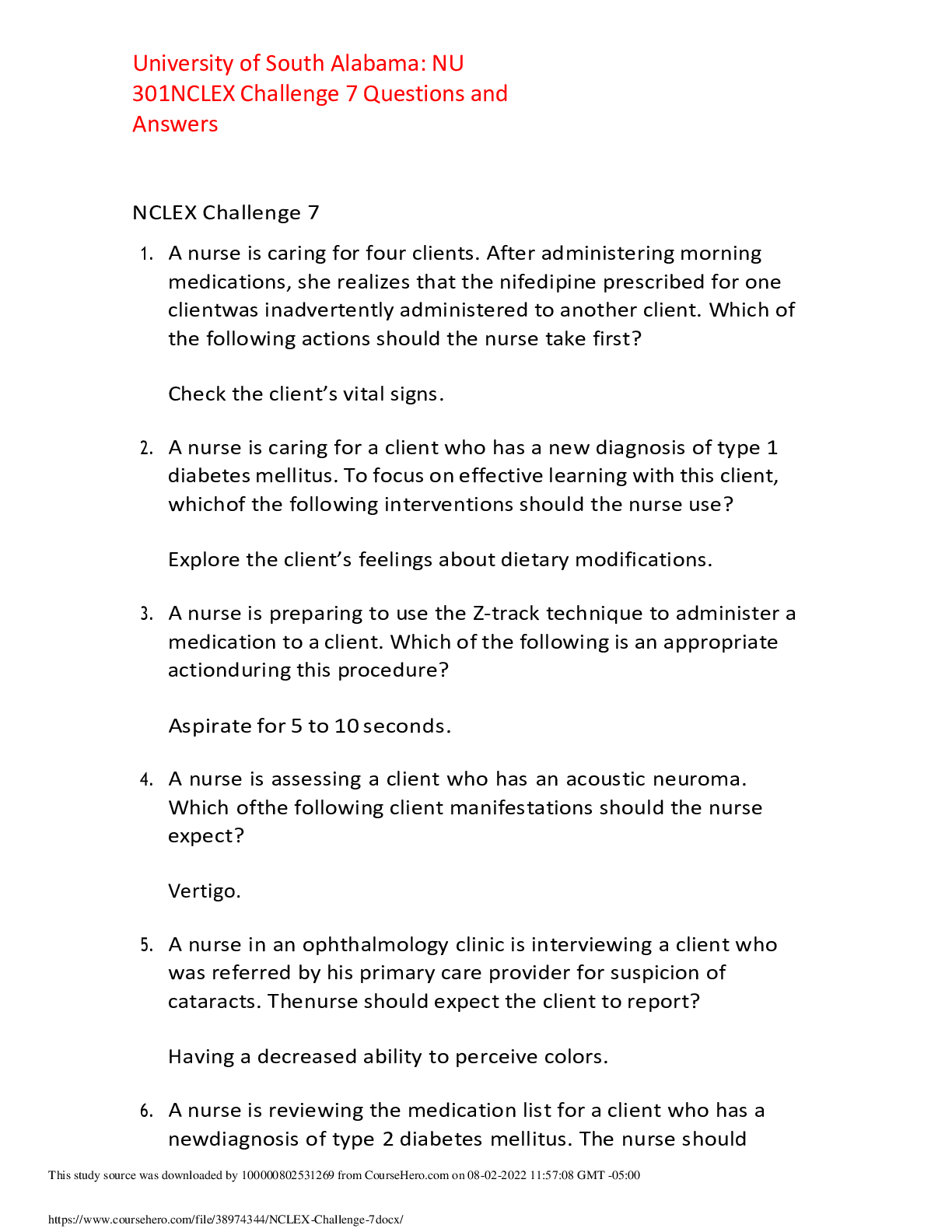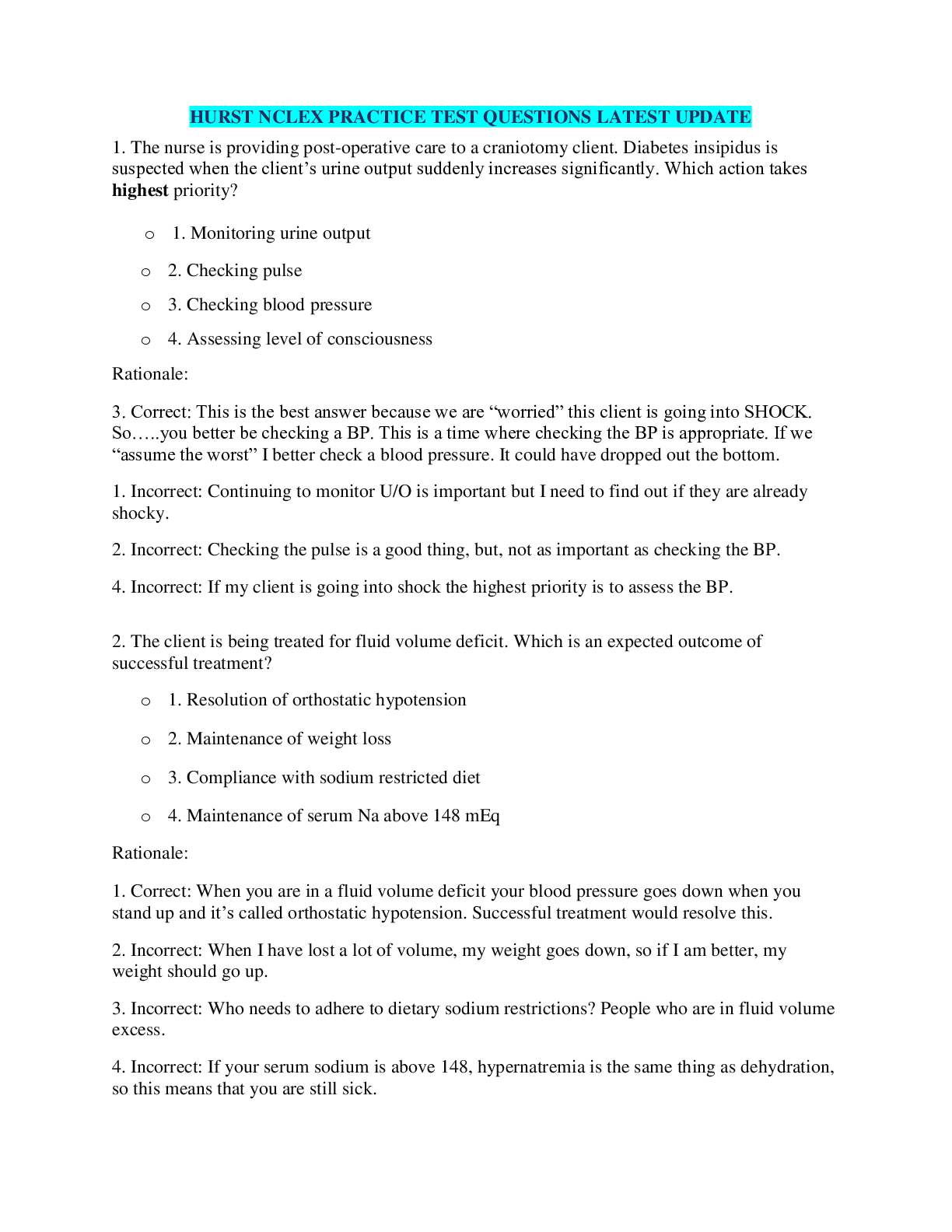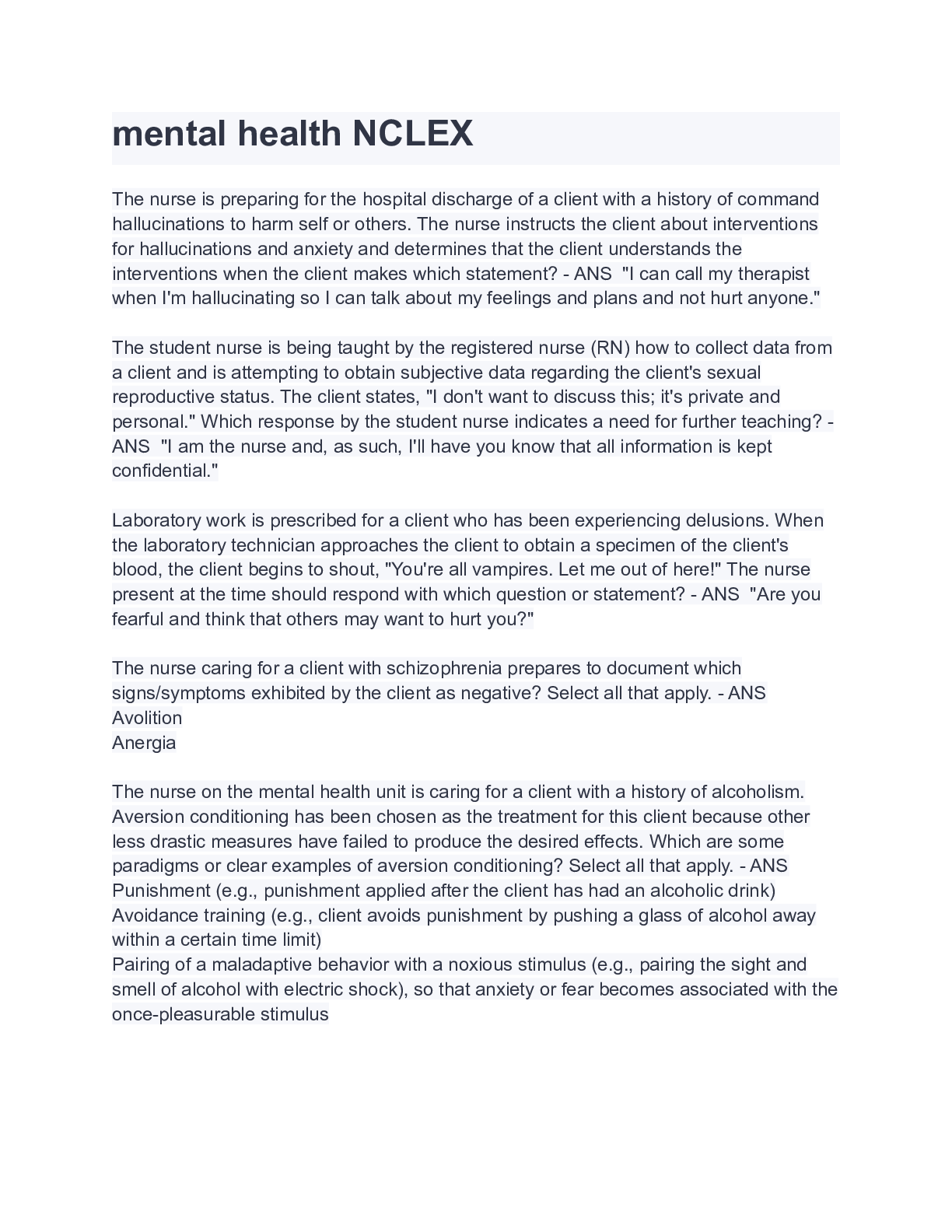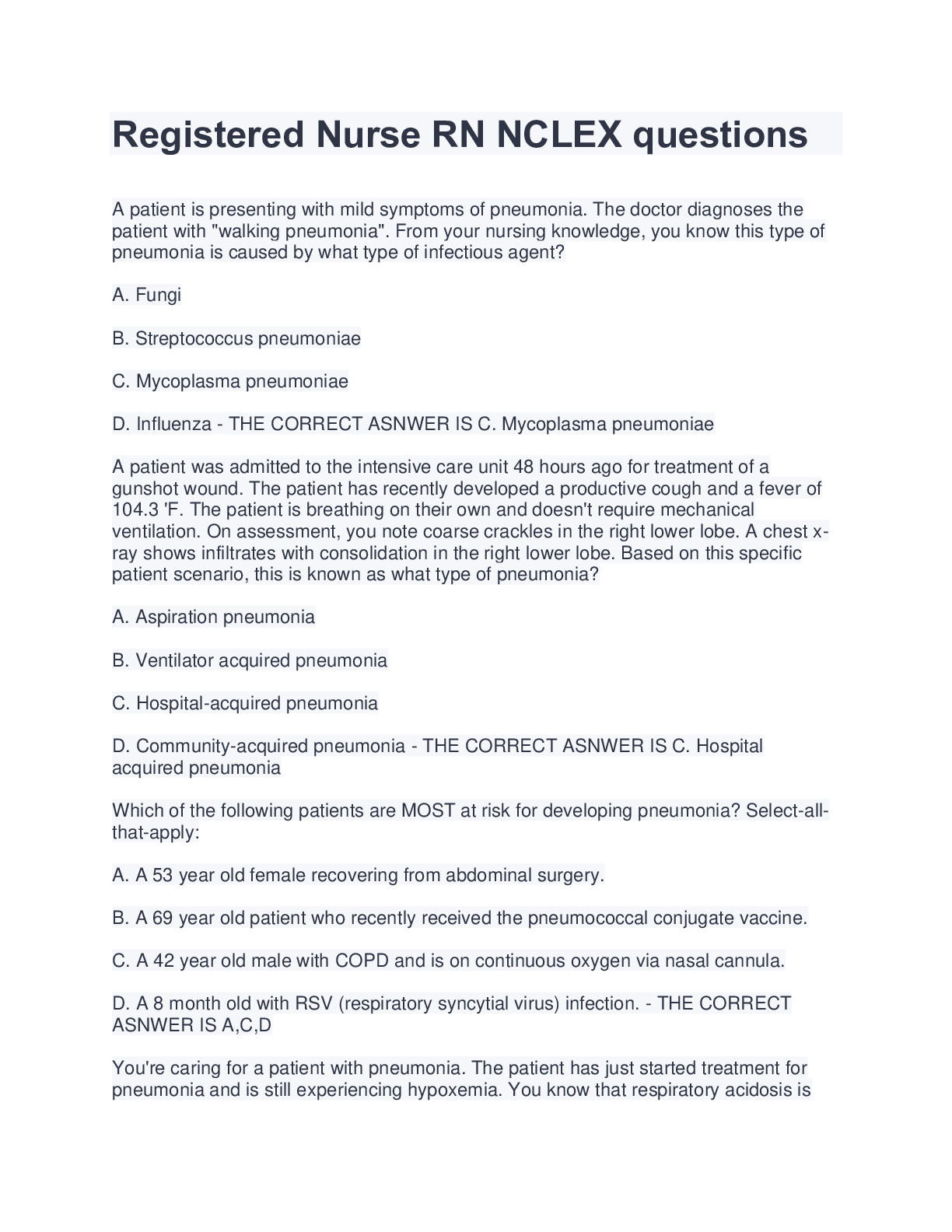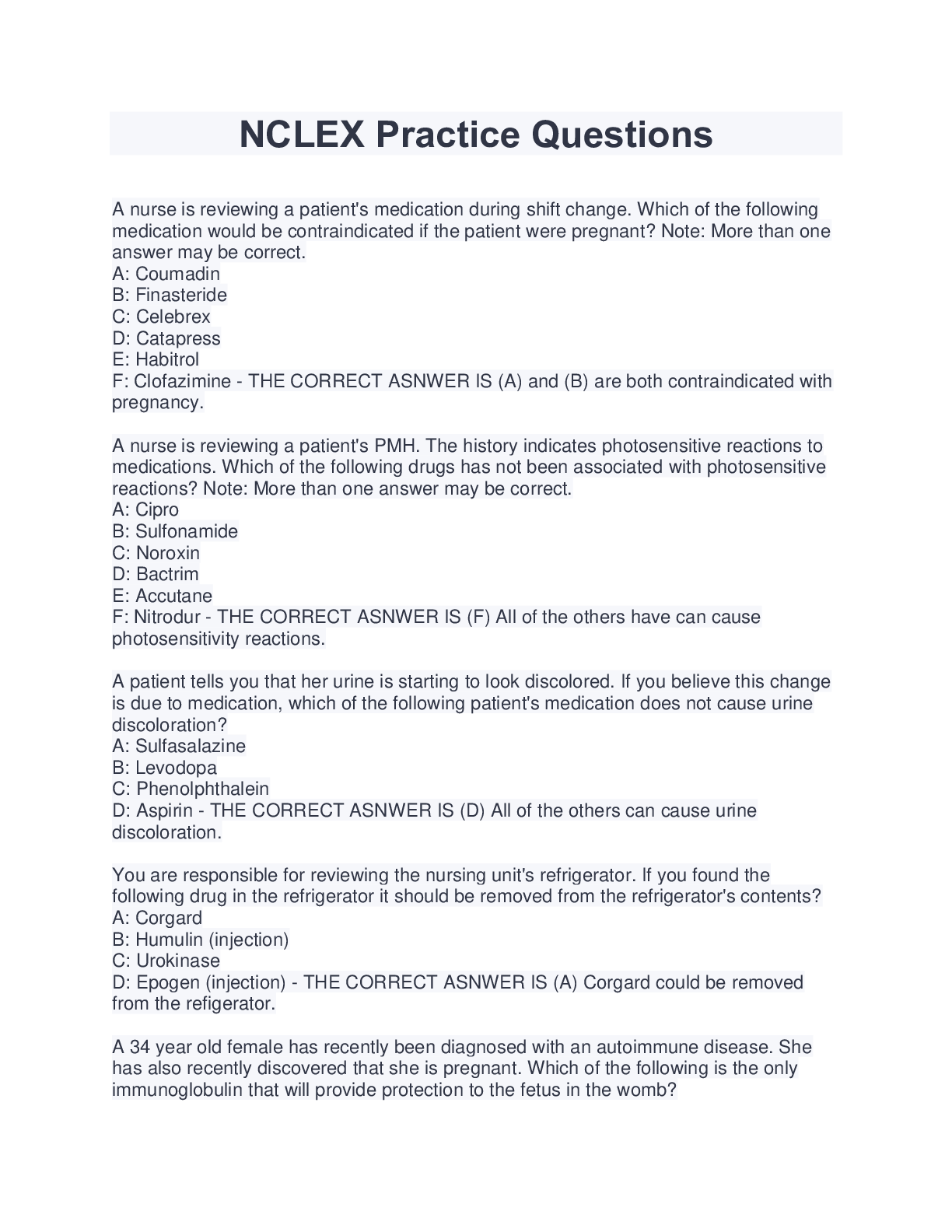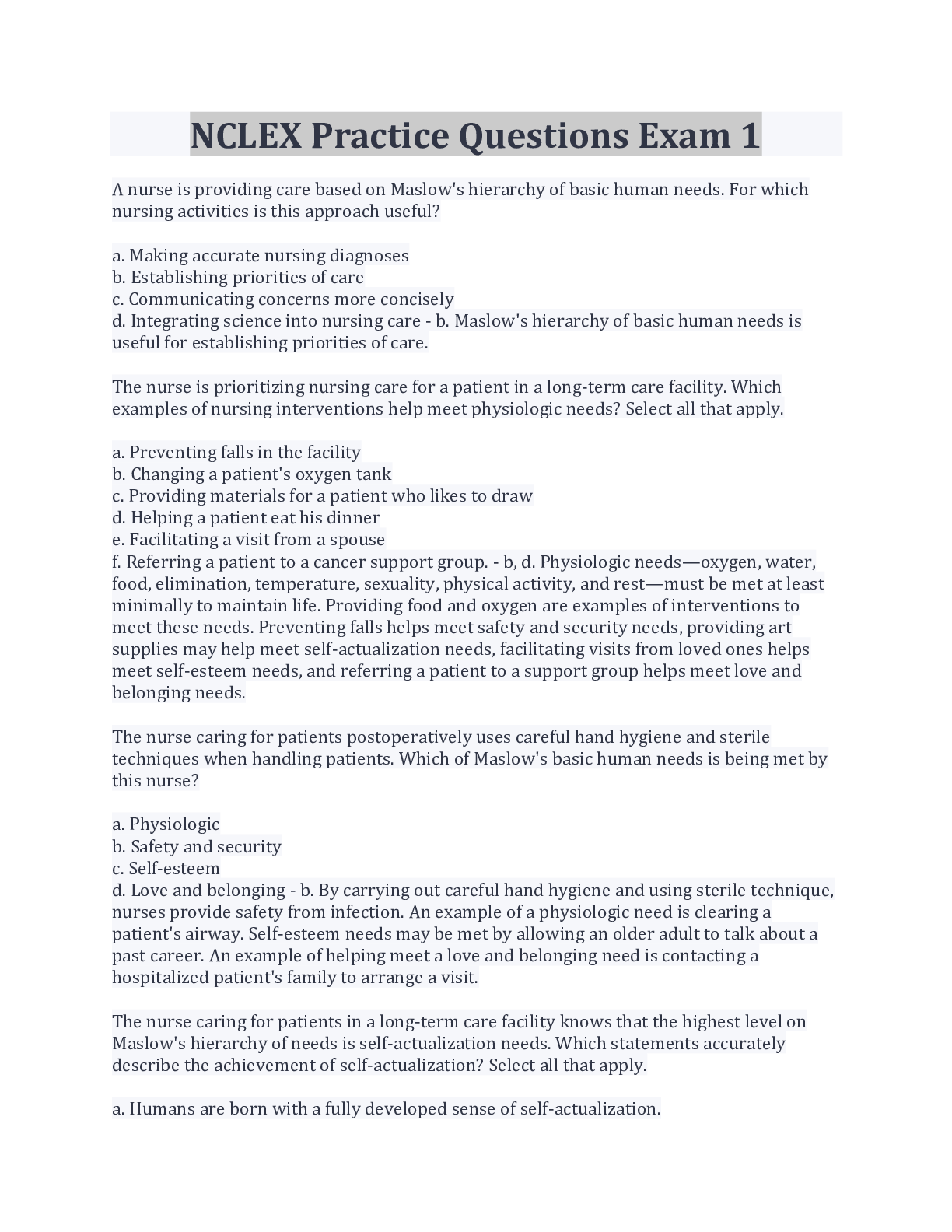*NURSING > NCLEX > NCLEX Nursing Fundamentals Module 4 Questions and answers {100%} | Nursing Fundamentals Module 4 {Gr (All)
NCLEX Nursing Fundamentals Module 4 Questions and answers {100%} | Nursing Fundamentals Module 4 {Graded A}
Document Content and Description Below
NCLEX Nursing Fundermentals Module 4 Questions and answers – Keiser University 1. The nurse is collecting data from a pregnant client when the client asks the nurse about the purpose of the fallo... pian tubes. Which is the accurate response the nurse should make? A. The organ of copulation B. Where the fetus develops C. Where fertilization occurs D. The organ 2. The nurse working in a prenatal clinic reviews a client's chart and notes that the primary health care provider documents that the client has a gynecoid pelvis. The nurse plans care understanding that which findings are characteristic of this type of pelvis? Select all that apply. A. Round shape B. Shallow depth C. Narrow pubic arch D. Diagonal conjugate measures 12.5 cm to 13 cm E. Blunt, somewhat widely separated ischial spines 3. The client asks the nurse about the purpose of the placenta. The nurse plans to respond to the client knowing which about the placenta? A. Cushions and protects the fetus B. Maintains the body temperature of the fetus C. Surrounds the fetus and allows for fetal movement D. Provides an exchange of nutrients and waste products between the mother and the fetus 4. The nurse is describing the process of fetal circulation to a client during a prenatal visit. The nurse should tell the client that fetal circulation consists of which components? A. Two umbilical veins and one umbilical arteryB. Two umbilical arteries and one umbilical vein C. Arteries that carry oxygenated blood to the fetus D. Veins that carry deoxygenated blood to the fetus 5. The nurse is reinforcing teaching to a pregnant woman about the physiological effects and hormonal changes that occur during pregnancy. The woman asks the nurse about the purpose of estrogen. The nurse bases the response on which purpose of estrogen? A. It maintains the uterine lining for implantation. B. It stimulates the metabolism of glucose and converts glucose to fat. C. It stimulates uterine development to provide an environment for the fetus and stimulates the breasts to prepare for lactation. D. It prevents the involution of the corpus luteum and maintains the production of progesterone until the placenta is formed. 6. A couple comes to the family planning clinic and asks about sterilization procedures. Which question by the nurse helps determine whether this method of family planning is appropriate? A. "Have either of you ever had surgery?" B. "Do you plan to have any other children?" C. "Do either of you have diabetes mellitus?" D. "Do either of you have problems with high blood pressure?" 7. The client arrives at the prenatal clinic for her first prenatal assessment. The client tells the nurse that the first day of her last menstrual period (LMP) was October 20, 2019. Using Nägele's rule, the nurse determines the estimated date of birth is which date? A. July 12, 2020 B. July 27, 2020 C. August 12, 2020 D. August 27, 2020 8. A pregnant client asks the nurse in the clinic when she will be able to start feeling the fetus move. The nurse responds by telling the mother that fetal movements will be noted between which weeks of gestation? A. 6 and 8 weeks' gestationB. 8 and 10 weeks' gestation C. 10 and 12 weeks' gestation D. 16 and 20 weeks' gestation 9. The nurse is collecting data from a client who is pregnant with twins. The client has a healthy 5-year-old child who was delivered at 38 weeks, and she tells the nurse that she does not have a history of any type of abortion or fetal demise. The nurse should document which as the GTPAL for this client? A. G = 3, T = 2, P = 0, A = 0, L = 1 B. G = 2, T = 1, P = 0, A = 0, L = 1 C. G = 1, T = 1, P = 1, A = 0, L = 1 D. G = 2, T = 0, P = 0, A = 0, L = 1 10. The nurse is collecting data from a client who is pregnant with triplets. The client also has a 3-year-old child who was born at 39 weeks' gestation. The nurse should document which gravida and para status on this client? A. Gravida I, Para II B. Gravida II, Para I C. Gravida II, Para II D. Gravida III, Para II 11. During a prenatal visit, the nurse is explaining dietary management to a client with diabetes mellitus. The nurse determines that the teaching has been effective when the client makes which statement? A. "I can eat more sweets now because I need more calories." B. "I need more fat in my diet so that the baby can gain enough weight." C. "I need to eat a high-protein, low-carbohydrate diet now to control my blood glucose." D. "I need to increase the fiber in my diet to control my blood glucose and prevent constipation." 12. The nurse is assigned to assist with caring for a client who is at risk for eclampsia. If the client progresses from preeclampsia to eclampsia, the nurse should take which action first? A. Administer oxygen by face mask. B. Clear and maintain an open airway.C. Check the blood pressure and the fetal heart tones. D. Prepare for the administration of intravenous magnesium sulfate. 13. The client is in her second trimester of pregnancy. She complains of frequent low back pain and ankle edema at the end of the day. The nurse should recommend which measure to help relieve both discomforts? A. Lie on the left side with the feet dorsiflexed. B. Soak the feet in hot water after performing 10 pelvic tilt exercises. C. Lie on the right side with the feet elevated on a pillow and a heating pad on the back. D. Lie on the floor with the legs elevated onto a couch or padded chair, with the hips and knees at a right angle. 14. The pregnant woman complains of being awakened frequently by leg cramps. The nurse reinforces instructions to the client's partner and should tell the client to perform which measure? A. Dorsiflex the client's foot while flexing the knee. B. Plantarflex the client's foot while flexing the knee. C. Dorsiflex the client's foot while extending the knee. D. Plantarflex the client's foot while extending the knee. 15. The nurse is monitoring a client with mild gestational hypertension (GH). Which data indicate that GH is a concern? A. Urinary output has increased. B. There is no evidence of proteinuria. C. The client complains of a headache and blurred vision. D. The blood pressure reading has returned to the prenatal baseline. 16. The nurse is monitoring a pregnant client with gestational hypertension (GH) who is at risk for preeclampsia. The nurse should check the client for which signs of preeclampsia? Select all that apply. A. Proteinuria B. Hypertension C. Low-grade fever D. Increased pulse rate E. Increased respiratory rate17. The nurse is assigned to care for a client who is in early labor. When collecting data from the client, which should the nurse check first? A. Baseline fetal heart rate B. Intensity of contractions C. Maternal blood pressure D. Frequency of contractions 18. Leopold's maneuvers will be performed on a pregnant client. The client asks the nurse about the procedure. Which information should the nurse provide to the client about Leopold's maneuvers? A. The maneuvers measure the height of the maternal fundus. B. The maneuvers determine the "lie" and "attitude" of the fetus. C. The maneuvers are a systematic method for palpating the fetus through the maternal back. D. The maneuvers are a systematic method for palpating the fetus through the maternal abdominal wall. 19. After a precipitous delivery, the nurse notes that the new mother is passive and only touches her newborn briefly with her fingertips. The nurse should do which to help the woman process what has happened? A. Support the mother in her reaction to the newborn. B. Encourage the mother to breastfeed soon after birth. C. Tell the mother that it is important to hold the newborn. D. Document a complete account of the mother's reaction in the birth record. 20.Which findings indicate to the nurse that placental separation has occurred? Select all that apply. A. Lengthening of umbilical cord B. Sudden trickle or spurt of blood C. Fundus is boggy following separation D. Change from globular to discoid shape E. Fetal membranes are seen at the introitus 21. A primipara is being evaluated in the clinic during her second trimester of pregnancy. Which occurrence indicates an abnormal physical finding that necessitates further testing?A. Quickening B. Braxton Hicks contractions C. Consistent increase in fundal height D. Fetal heart rate of 180 beats per minute 22.The nurse is collecting data from a pregnant client who is currently at 28 weeks' gestation. At her prior prenatal visit, her fundal height measured 22 cm. The nurse measures the fundal height at this visit in centimeters and should expect which finding? A. 22 cm B. 26 cm C. 32 cm D. 40 cm 23.A pregnant client is seen in the health care clinic for a regular prenatal visit. The client tells the nurse that she is experiencing irregular contractions. The nurse determines that the client is experiencing Braxton Hicks contractions. Based on this finding, which nursing action is appropriate? A. Contact the health care provider. B. Instruct the client to maintain bed rest for the remainder of the pregnancy. C. Tell the client that these are common and they may occur throughout the pregnancy. D. Call the maternity unit and inform them that the client will be admitted in a prelabor condition. 24.The nurse is checking a client's record for probable signs of pregnancy. Which are the probable signs of pregnancy that the nurse should note? Select all that apply. A. Ballottement B. Chadwick’s sign C. Uterine Enlargement D. Braxton Hicks Contractions E. Outline of fetus via radiography or ultrasound F. Fetal heart rate detected by a nonelectronic device25. The nursing instructor asks a nursing student to describe the process of quickening. Which statement indicates an understanding of this term? A. "It is the fetal movement that is felt by the mother." B. "It is the compressibility of the lower uterine segment." C. "It is the irregular, painless contractions that occur throughout pregnancy." D. "It is the soft blowing sound that can be heard when the uterus is auscultated." 26.The client is undergoing an amniocentesis at 16 weeks' gestation to detect the presence of biochemical or chromosomal abnormalities. Which instructions should the nurse reinforce to the client? A. The bladder must be full during the examination. B. The bladder must be empty during the examination. C. She should not eat or drink anything 4 to 6 hours before the examination. D. She will be given Rho(D) immune globulin because she is Rh positive. 27. While assisting with the measurement of fundal height, the client at 36 weeks' gestation states that she is feeling lightheaded. On the basis of the nurse's knowledge of pregnancy, the nurse determines that this is most likely a result of which reason? A. A full bladder B. Emotional instability C. Insufficient iron intake D. Compression of the vena cava 28.A contraction stress test is scheduled for the client. The woman asks the nurse about the test. Which response describes the most accurate description of the test? A. "Uterine contractions are stimulated by Leopold's maneuvers." B. "The uterus is stimulated to contract by either small amounts of oxytocin or by nipple stimulation." C. "An internal fetal monitor is attached, and you will walk on a treadmill until contractions begin." D. "Small amounts of oxytocin are administered during internal fetal monitoring to stimulate uterine contractions."29.The perinatal client is admitted to the obstetrical unit during an exacerbation of a heart condition. When planning for the nutritional requirements of the client, the nurse should consult with the dietitian to ensure which dietary measure? A. A low-calorie diet to ensure the absence of weight gain B. A diet that is high in fluids and fiber to decrease constipation C. A diet that is low in fluids and fiber to decrease blood volume D. Unlimited sodium intake to increase the circulating blood volume 30.The nurse caring for a client with abruptio placentae is monitoring the client for signs of disseminated intravascular coagulopathy (DIC). The nurse should suspect DIC if which is observed? A. Rapid clotting times B. Pain and swelling of the calf of one leg C. Laboratory values that indicate increased platelets D. Petechiae, oozing from injection sites, and hematuria 40.The client is admitted to the labor suite complaining of painless vaginal bleeding. The nurse assists with the examination of the client, knowing that which routine labor procedure is contraindicated? A. Leopold's maneuvers B. A manual pelvic examination C. Hemoglobin and hematocrit evaluation D. External electronic fetal heart rate monitoring 41.The nurse is assigned to assist with caring for a client with abruptio placentae who is experiencing vaginal bleeding. The nurse collects data from the client, knowing that abruptio placentae is accompanied by which additional finding? A. Soft abdomen on palpation B. Uterine tenderness on palpation C. No complaints of abdominal pain D. Lack of uterine irritability or tetanic contractions 42.The nurse is collecting data from a client who has been diagnosed with placenta previa. Which findings should the nurse expect to note? Select all that apply. A. Uterine rigidity B. Uterine tendernessC. Severe abdominal pain D. Bright red vaginal bleeding E. Soft, relaxed, nontender uterus 43.The nurse is assisting with caring for a client with abruptio placentae. While caring for the client, the nurse notes that the client begins to develop signs of shock. The nurse should take which action first? A. Monitor the urinary output. B. Monitor the maternal pulse. C. Turn the client onto her side. D. Monitor the maternal blood pressure. 44.A woman in active labor has contractions every 2 to 3 minutes that last for 45 seconds. The fetal heart rate between contractions is 100 beats per minute. On the basis of these findings which is the priority nursing action? A. Monitor the maternal vital signs. B. Notify the registered nurse (RN) immediately. C. Continue monitoring labor and the fetal heart rate. D. Encourage relaxation and breathing techniques between contractions. 45.The nurse is assigned to assist with caring for a client who is being admitted to the birthing center in early labor. During admission, which action should the nurse take initially? A. Estimate the fetal size. B. Check pelvic adequacy. C. Administer an analgesic. D. Determine the maternal and fetal vital signs. 46.The nurse is assigned to work in the delivery room and is assisting with caring for a client who has just delivered a newborn. The nurse is monitoring for signs of placental separation knowing that which indicates that the placenta has separated? A. A change in the uterine contour B. Sudden and sharp abdominal pain C. A shortening of the umbilical cord D. A decrease in blood loss from the introitus47.The client received epidural anesthesia during labor and had a forceps delivery after pushing for 2 hours. At 6 hours postpartum, the client's systolic blood pressure (BP) dropped 20 points, the diastolic BP dropped 10 points, and her pulse is 120 beats per minute. The client is very anxious and restless. The nurse is told that the client has a vulvar hematoma. Based on this diagnosis, the nurse should plan which action? A. Reassure the client. B. Apply perineal pressure. C. Monitor fundal height. D. Prepare the client for surgery. 48.A postpartum client is getting ready for discharge. The nurse suspects that the client needs further teaching related to breastfeeding when she makes which statement? A. "I don't need birth control because I will be breastfeeding." B. "I need to increase my caloric intake by 500 calories a day." C. "I shouldn't use soap to wash my breasts because I will be breastfeeding." D. "I need to be sure that I increase my fluid intake and take my prenatal vitamins while breastfeeding." 49.The nurse palpates the fundus and checks the character of the lochia of a postpartum client who is in the fourth stage of labor. Which lochia characteristic should the nurse expect to note? A. Red B. Pink C. White D. Serosanguineous 50.After episiotomy and the delivery of a newborn, the nurse performs a perineal check on the mother. The nurse notes a trickle of bright red blood coming from the perineum. The nurse checks the fundus and notes that it is firm. Which determination should the nurse make? A. This is a normal expectation after episiotomy. B. The mother should be allowed bathroom privileges only. C. The bright red bleeding is abnormal and should be reported.D. The perineal assessment should be performed more frequently. 51.The nurse is assigned to care for the client during the postpartum period. The client asks the nurse what the term involution means. Which description should the nurse give to the client? A. The inverted uterus returning to normal B. The gradual reversal of the uterine muscle into the abdominal cavity C. The descent of the uterus into the pelvic cavity, which occurs at a rate of 2 cm/day D. The progressive descent of the uterus into the pelvic cavity, which occurs at a rate of approximately 1 cm/day 52.After delivery the nurse checks the height of the uterine fundus. Which position of the fundus should the nurse expect to note? A. To the right of the abdomen B. At the level of the umbilicus C. About 4 cm above the level of the umbilicus D. One fingerbreadth above the symphysis pubis 53.The nurse is caring for a postpartum client. At 4 hours postpartum, the client's temperature is 102° F (38.9° C). Which is the appropriate nursing action? A. Apply cool packs to the abdomen. B. Continue to monitor the temperature. C. Remove the blanket from the client's bed. D. Notify the registered nurse (RN), who will then contact the primary health care provider (PHCP). 54. The nurse is assisting with planning care for a postpartum woman who has small vulvar hematomas. To assist with reducing the swelling, the nurse should perform which action? A. Check vital signs every 4 hours. B. Measure the fundal height every 4 hours. C. Prepare a heat pack for application to the area. D. Prepare an ice pack for application to the area.55.The nurse is assigned to care for the client after a cesarean section. To prevent thrombophlebitis, the nurse should encourage the woman to take which priority action? A. Ambulate frequently. B. Wear support stockings. C. Apply warm, moist packs to the legs. D. Remain on bed rest, with the legs elevated. 56.Rho(D) immune globulin is prescribed for a client after delivery and the nurse provides information to the client about the purpose of the medication. The nurse determines that the woman understands the purpose if the woman states that it will protect her next baby from which condition? A. Having Rh-positive blood B. Developing a rubella infection C. Developing physiological jaundice D. Being affected by Rh incompatibility 57.A male client has a tentative diagnosis of urethritis. The nurse should assess the client for which manifestation of the disorder? A. Hematuria and pyuria B. Dysuria and proteinuria C. Hematuria and urgency D. Dysuria and penile discharge 58.The nurse is caring for a client who is taking phenytoin for control of seizures. During data collection, the nurse notes that the client is taking birth control pills. Which information should the nurse provide to the client? A. Pregnancy should be avoided while taking phenytoin. B. The client may stop taking the phenytoin if it is causing severe gastrointestinal effects. C. The potential for decreased effectiveness of the birth control pills exists while taking phenytoin. D. The increased risk of thrombophlebitis exists while taking phenytoin and birth control pills together.59.The nurse is assisting with caring for a client who has a placenta previa. The nurse understands that a cervical examination should not be performed on the client primarily because it could have which consequence? A. Cause hemorrhage B. Initiate premature labor C. Rupture the fetal membranes D. Increase the chance of infection 60.The nursing instructor asks the nursing student about the physiology related to the cessation of ovulation that occurs during pregnancy. Which response by the student indicates an understanding of this physiological process? A. "Ovulation ceases during pregnancy because the circulating levels of estrogen and progesterone are high." B. "Ovulation ceases during pregnancy because the circulating levels of estrogen and progesterone are low." C. "The low levels of estrogen and progesterone increase the release of folliclestimulating hormone and luteinizing hormone." D. "The high levels of estrogen and progesterone promote the release of folliclestimulating hormone and luteinizing hormone." 61.The nurse is reviewing the health record of a pregnant client at 16 weeks' gestation. The nurse should expect to document that the fundus of the uterus is located at which area? A. At the umbilicus B. Just above the symphysis pubis C. At the level of the xiphoid process D. Midway between the symphysis pubis and the umbilicus 62.A male client has a tentative diagnosis of urethritis. The nurse collects data from the client knowing that which are signs/symptoms of this disorder? A. Hematuria and pyuria B. Dysuria and proteinuria C. Dysuria and penile discharge D. Hematuria and penile discharge63.A male client is diagnosed with urethritis caused by chlamydial infection. The unlicensed assistive personnel (UAP) assigned to the client asks the nurse what measures are necessary to prevent a contraction of the infection during care. Which instruction should the nurse give the UAP? A. Enteric precautions should be instituted for the client. B. Gloves and mask should be used when in the client's room. C. Contact isolation should be initiated because the disease is highly contagious. D. Standard precautions are sufficient because the infection is transmitted sexually. 64.The nurse is checking lochia discharge on a client in the immediate postpartum period and notes that the lochia is bright red and contains some small clots. Which interpretation should the nurse make about this finding? A. The finding is normal. B. The finding indicates that the client is hemorrhaging. C. The finding indicates the need to increase oral fluids. D. The finding indicates the need to contact the primary health care provider (PHCP). 65.A nulliparous woman asks the nurse when she will feel fetal movements. The nurse responds by telling the woman that the first recognition of fetal movement will occur at approximately which week of gestation? A. 10 B. 12 C. 14 D. 18 66.The nurse is performing a vaginal check of a pregnant client in labor. The nurse notes that the umbilical cord is protruding from the vagina. Which action should the nurse immediately perform? A. Administer oxygen to the client. B. Transport the client to the delivery room. C. Place an external fetal monitor on the client. D. Exert upward pressure against the presenting part with gloved fingers.67.A pregnant client in the second trimester of pregnancy is admitted to the maternity unit with a suspected diagnosis of abruptio placentae. Which finding should the nurse expect to note if this condition is present? A. Soft uterus B. Abdominal pain C. Nontender uterus D. Painless vaginal bleeding 68.The nurse in the labor room is caring for a client in the first stage of labor. When monitoring the fetal patterns, the nurse notes an early deceleration of the fetal heart rate (FHR) on the monitor strip. Which is the appropriate nursing action? A. Notify the registered nurse. B. Administer oxygen via face mask. C. Place the mother in Trendelenburg's position. D. Document the findings and continue to monitor the fetal patterns. 69.The nurse is preparing a pregnant client for a transvaginal ultrasound exam. The nurse should tell the client that which will occur? A. The client will be placed in the supine position. B. The client will feel some pain during the procedure. C. The client will feel some pressure when the vaginal probe is moved. D. The client will need to drink 2 quarts of water to attain a full bladder. 70.A postpartum client with mastitis in the right breast complains that the breast is too sore for her to breastfeed her infant. Which should the nurse tell the client? A. "Pump both breasts and discard the milk." B. "The infant should be bottle-fed temporarily." C. "Breastfeed from the left breast and gently pump the right breast." D. "Stop breastfeeding from both breasts until this condition resolves." All questions have come from the NCLEX-PN Examination 7th Edition [Show More]
Last updated: 1 year ago
Preview 1 out of 15 pages
 Questions and answers – Keiser University.png)
Reviews( 0 )
Document information
Connected school, study & course
About the document
Uploaded On
Feb 16, 2021
Number of pages
15
Written in
Additional information
This document has been written for:
Uploaded
Feb 16, 2021
Downloads
0
Views
44

 Questions and answers – Keiser University.png)
 Questions and answers – Keiser University.png)
 Questions and answers – Keiser University.png)
 Questions and answers – Keiser University.png)
 Questions and answers – Keiser University.png)
